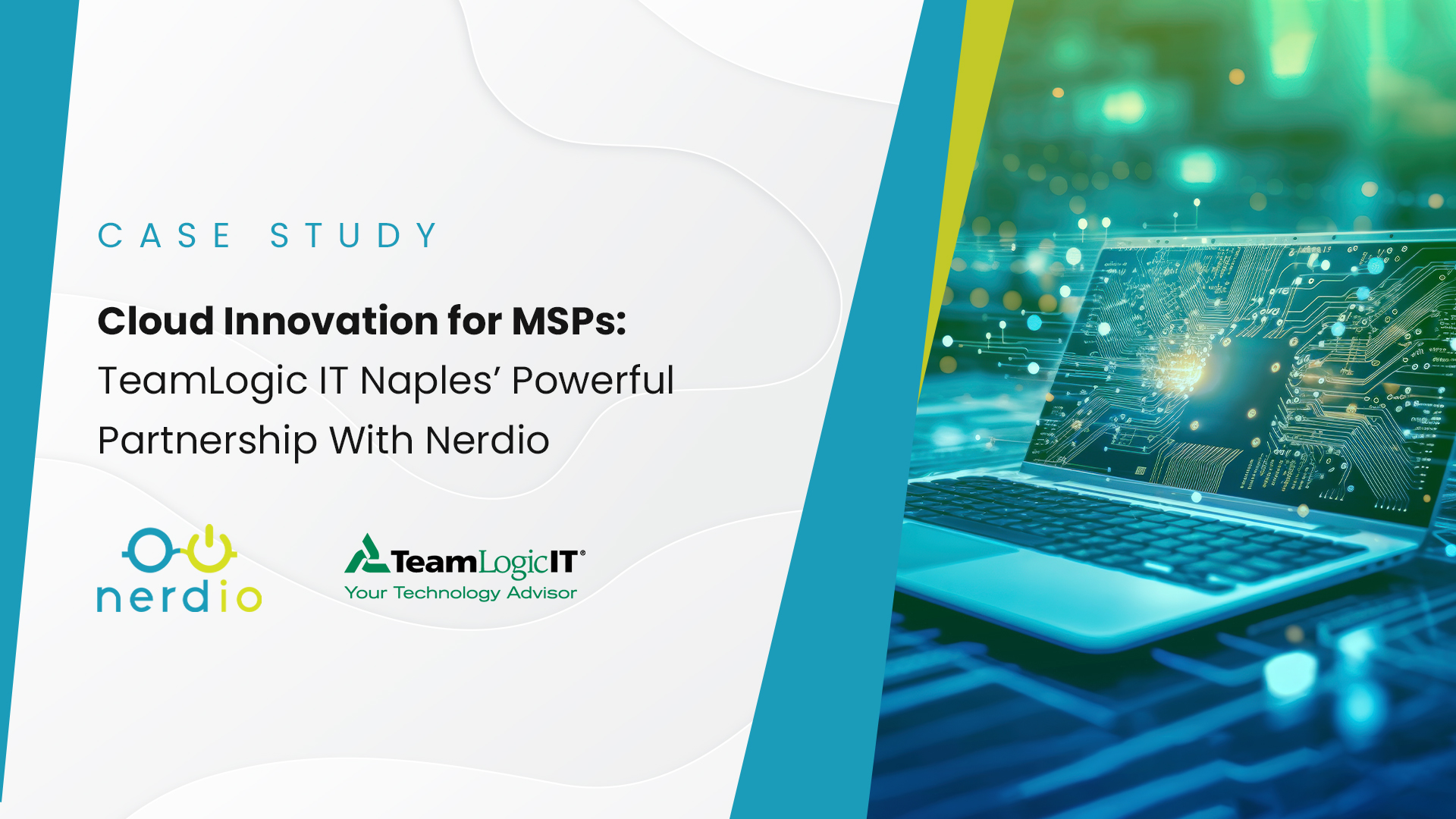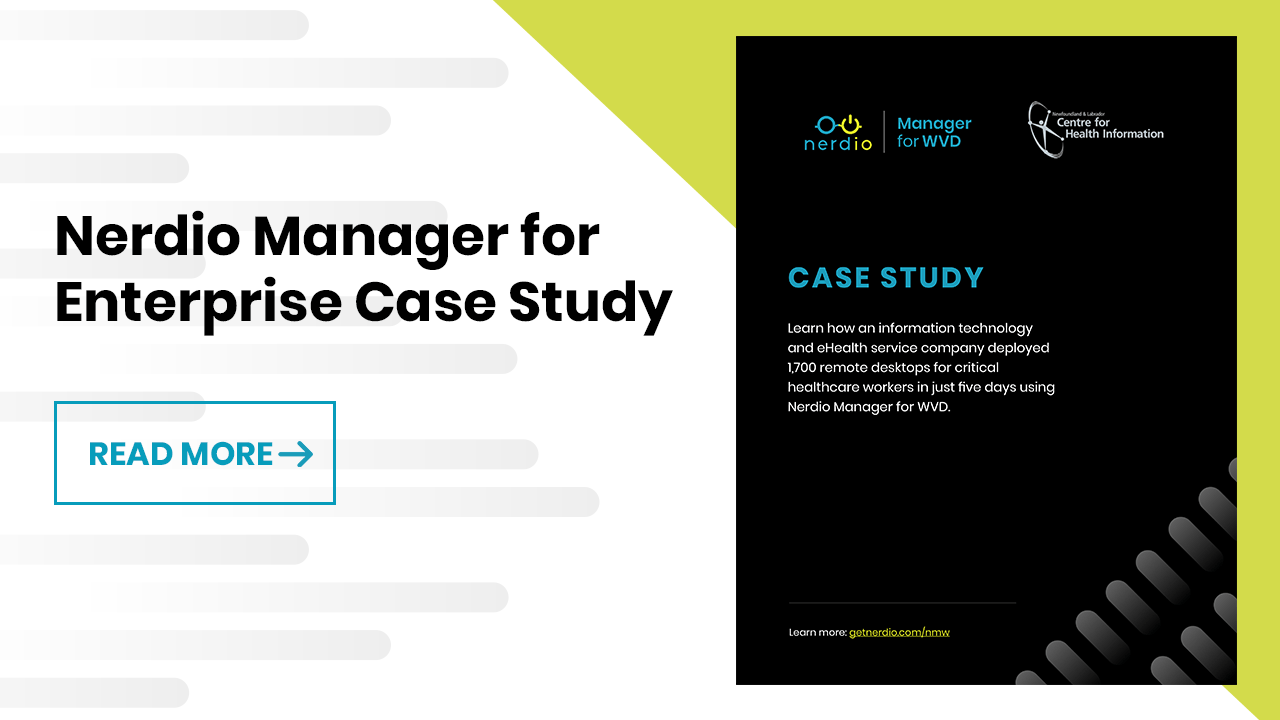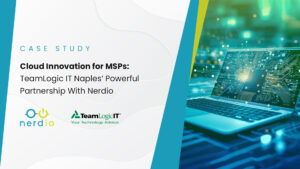Case Study
Learn how an information technology and eHealth service company deployed 1,700 remote desktops for critical healthcare workers in just five days using Nerdio Manager for Enterprise .
About Newfoundland and Labrador Centre for Health Information
Newfoundland and Labrador Centre for Health Information (NLCHI) supports healthcare organizations across the province with IT services. In response to COVID-19, the organization had to enable remote work quickly. In five days, NLCHI deployed Azure Virtual Desktop (AVD) to 1,700 healthcare workers, who connect to their Windows desktops and apps with their own devices. Using Windows 10 Enterprise multi-session, the organization saves compute costs by enabling 32 users to connect to a session host instead of just two.
The Newfoundland and Labrador Centre for Health Information (NLCHI) provides quality information to health professionals, the public, researchers, and health system decision-makers in Newfoundland and Labrador in Canada. Through collaboration with the health system, NLCHI is helping build a smarter, more connected healthcare system by developing data and technical standards, maintaining key health databases, and supporting health research. The province is divided into four regional health authorities (RHAs): Labrador-Grenfell Health, Central Health, Western Health, and Eastern Health.
NLCHI’s staff of 175 supports 20,000 healthcare workers with solutions such as hospital information systems, an electronic health record (EHR) system that authorized healthcare providers to securely access essential patient data, and an electronic medical record (EMR) program that is digitizing clinician offices across the province. In the end, all of these machines and roles need to be maintained, patched, kept free from viruses.
Moving to remote work and the cloud amid the COVID-19 pandemic
In early 2020, roughly 400 of the province’s 20,000 healthcare workers regularly worked remotely using VPN connections and corporate laptop computers. Thanks to its e-health focus, NLCHI had recently established a single Microsoft 365 tenant for itself and the four RHAs, including Microsoft Teams. The rest of its IT infrastructure was mostly on-premises.
In early March 2020, when the province confirmed its first cases of COVID-19, NLCHI had to respond quickly to keep healthcare services running. At the same time, it had to configure new COVID-19 intensive-care unit (ICU) wings and deploy solutions in long-term care facilities (NLCHI provided 500 iPads and various apps to help patients connect with family and health providers). Robert Drover, Director of NLCHI, says, “Case counts and admissions accelerated overnight. It was a critical situation and we needed to enable remote work for as many workers as possible; staff responsible for acquiring personal protection equipment are just as essential as ICU physicians and nurses to keep services running.”
Fast deployment, cost savings, and minimal training requirements
NLCHI contacted Microsoft, which suggested Azure Virtual Desktop for providing remote access. Rodney Keough, Data Center and Unified Communications Manager at NLCHI, recalls late night and early morning calls with Microsoft to determine how to set the service up for NLCHI and the four RHAs with their different requirements. ”Robert contacted me on a Sunday night. We built out the main controllers in Microsoft Azure by Thursday morning, when we brought on the first pilot group from Eastern Health. In five days, we had about 1,700 people using the new Azure Virtual Desktop platform, with peak usage at 3,700 people.”
To reduce its resource requirements, NLCHI used Windows 10 Enterprise multi-session, a Remote Desktop Session Host that allows multiple concurrent interactive sessions.
NLCHI created materials explaining how employees could access their remote desktops by using their own personal devices. Keough says, “Beyond creating an announcement email and a couple of support documents, there was no more training required. The experience is intuitive, just like the desktop workers are already used to.”
NLCHI also worked with Nerdio to set up Nerdio Manager for Enterprise — an enterprise solution to help automate management, optimization, and security of Azure Virtual Desktop deployments. The organization used Nerdio Manager for AVD, which works with NLCHI’s four Azure Active Directory P1 deployments, to create an image for itself and for each RHA, and automatically deploy them to each domain. “We also deployed servers with credentials and connected them to Azure file stores quickly using the Nerdio interface,” says Keough.
To make its Azure spend more efficient, the organization uses Azure Reserved Virtual Machine Instances to manage costs across predictable workloads. It also uses auto-scaling in Nerdio Manager for Enterprise to handle its fluctuating needs (at the end of each workday, the organization scales down from 30 servers to just one). “The ability to scale down automatically helps us save on compute costs for Azure; that’s not something that was available in our traditional datacenter model. We built a sustainable solution that’s fiscally responsible and will help us recover some of its costs,” says Keough.
Instead of two users per CPU, we can enable 32 users to connect to one session host, and all get equal performance and a full desktop experience… It cuts our costs by a factor of 30. – Rodney Keough: Data Center and Unified Communications Manager, Newfoundland and Labrador Centre for Health Information
Flexibility, security, and a new direction for IT
The organization benefits from the flexibility it gained around devices. Keough says, “We don’t have to secure workers’ computers with encrypted drives and security updates because the devices are just acting like a thin client, in the sense that they’re providing the connection to our virtual desktop infrastructure.” Drover points out that while NLCHI doesn’t anticipate increased funding or resources, expectations from and requirements for its IT services keep growing. “Azure Virtual Desktop and Nerdio Manager for Enterprise will help us automate and improve our services quickly to keep up with demand,” he says.
NLCHI sees virtualization as an opportunity to rethink how it procures and delivers devices—and provides a desktop experience for workers. The organization won’t have to image new computers for remote workers, and it can focus more on identity management and security. Workers won’t need different usernames and passwords for various applications but will instead have a single Microsoft identity that IT staff can manage across the environment. Keough says, “Next, we can look at using Microsoft Intune mobile device management across the entire organization like we’re doing for the 500 new iPads.”
The organization is also looking into migrating its entire remote desktop environment to Azure Virtual Desktop, and using the service for application delivery. “Azure Virtual Desktop enlightened us about the power of Azure—we’re looking at it as part of our data center portfolio, and we’re evaluating more application-level and server-level workloads to migrate to the service,” says Keough.
Drover sees the Azure Virtual Desktop deployment as changing the organization’s strategy around what it can achieve. “We’ve advanced our capabilities quickly, achieving in nine months what would have taken us 5 or 10 years to do previously. We’re seeing intrinsic benefits that make us more effective, efficient, and responsive,” he says.
In summary, Keough says, “We chose Azure Virtual Desktop paired with Nerdio Manager for Enterprise because of the close collaboration and trust that we have with Microsoft. The companies have the best interests of our organization and our patients, clients, and residents in mind. Our workers can use their own devices to access internal resources while we still maintain our security principles. The fit is phenomenal when it comes to performance and flexibility.”
“We’ve advanced our capabilities quickly, achieving in nine months what would have taken us 5 or 10 years to do previously. We’re seeing intrinsic benefits that make us more effective, efficient, and responsive. ” – Robert Drover: Director, Newfoundland and Labrador Centre for Health Information
Download the application today from the Azure marketplace and begin a free 30-day trial: nerdio.co/nme
Find Nerdio in the Azure Marketplace: nerdio.co/nme











